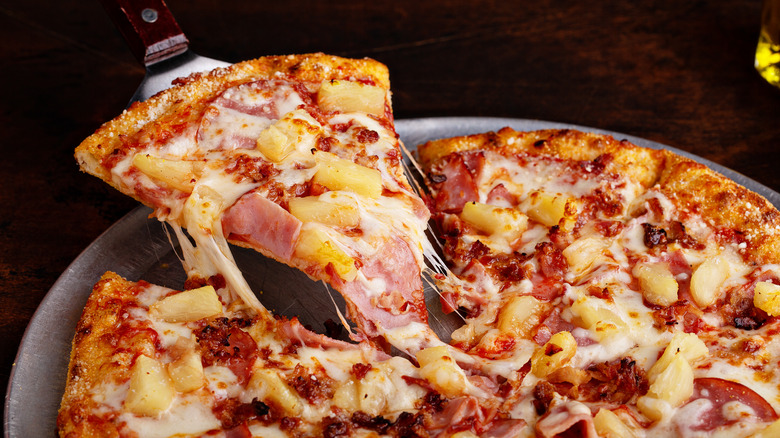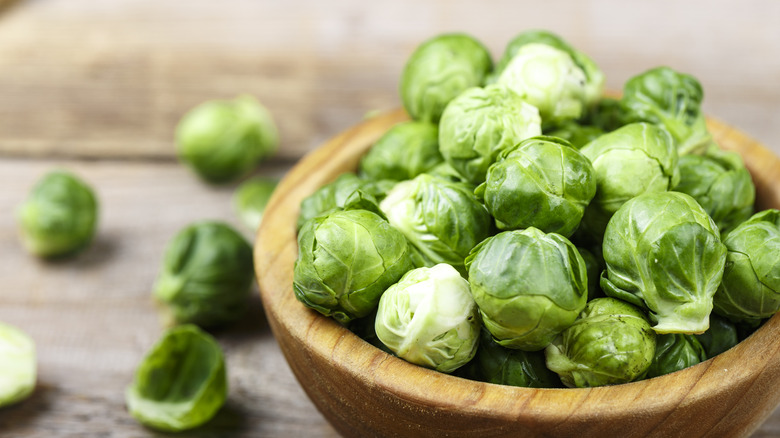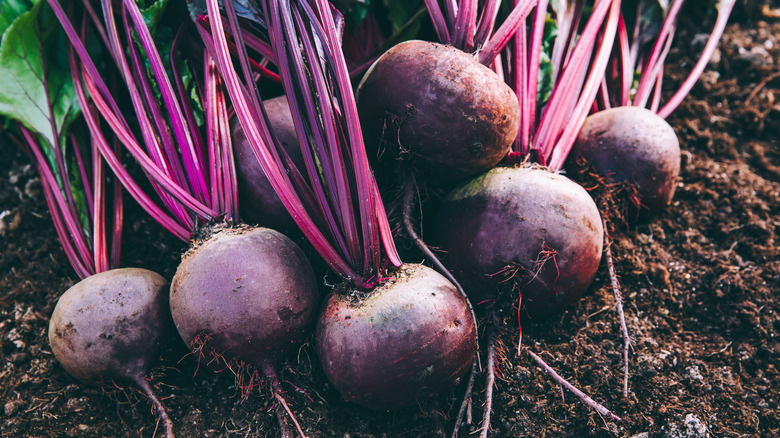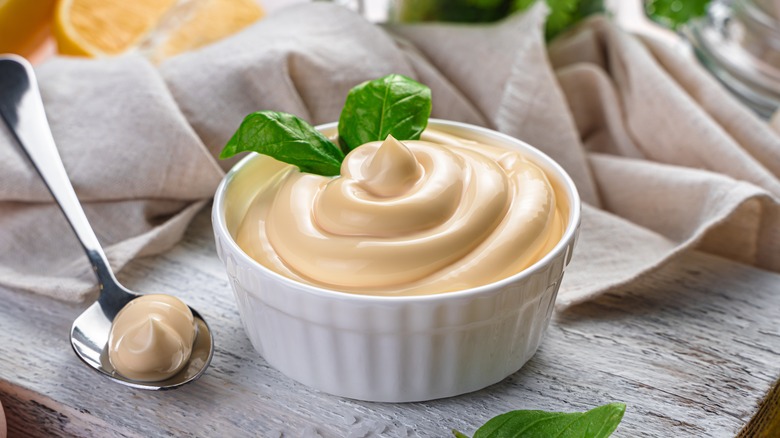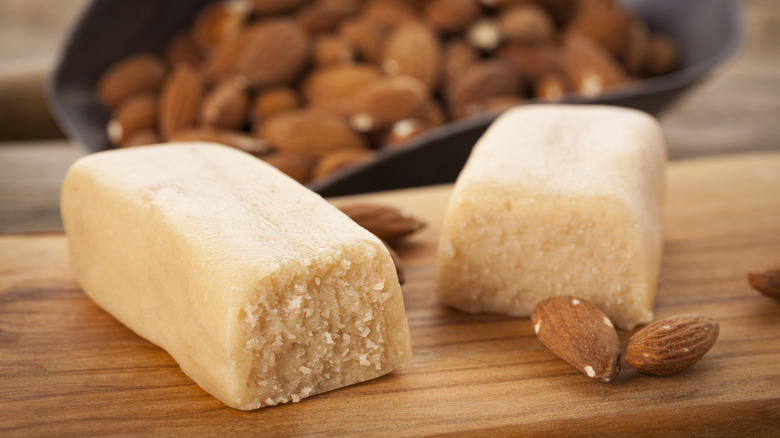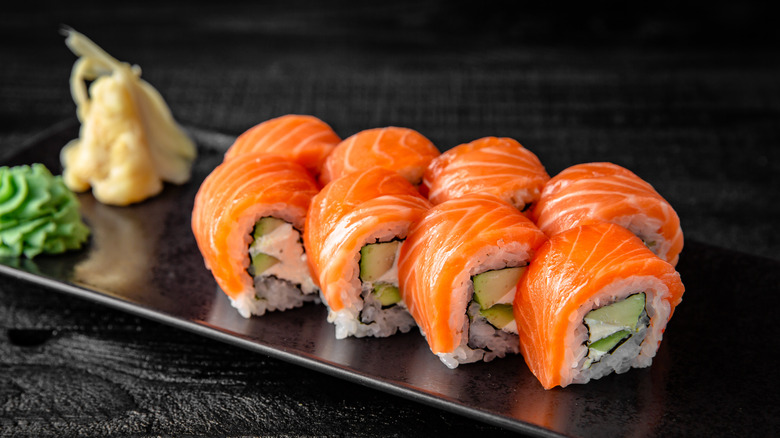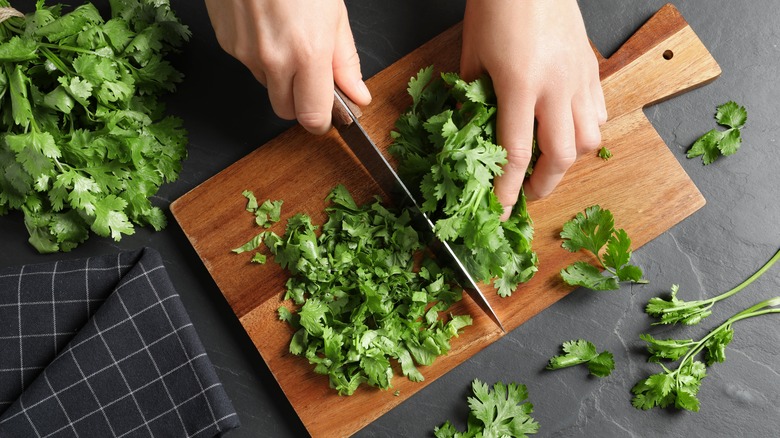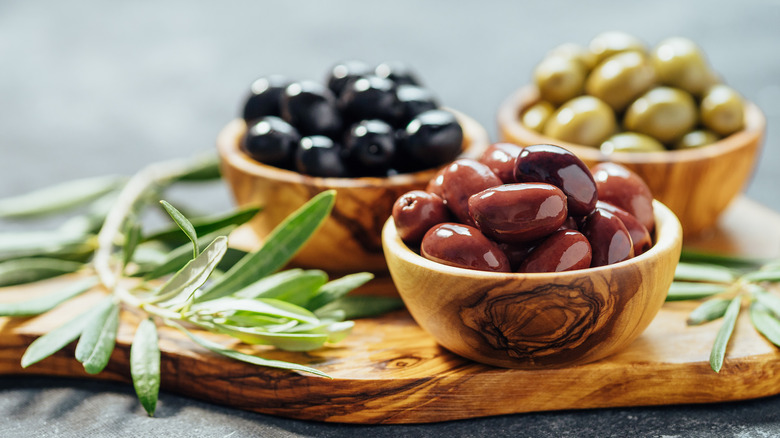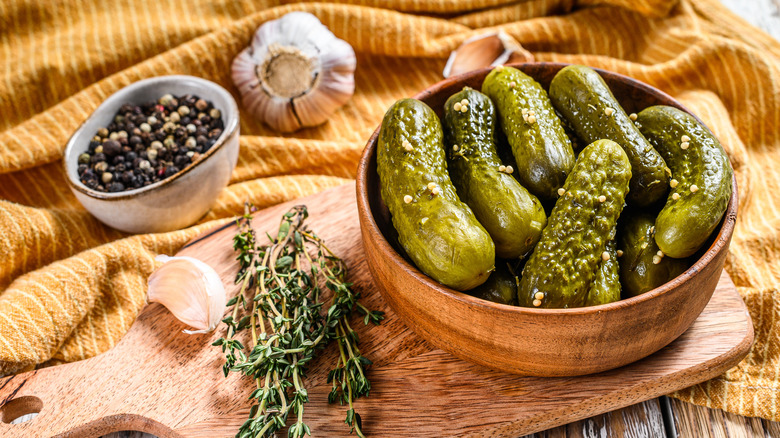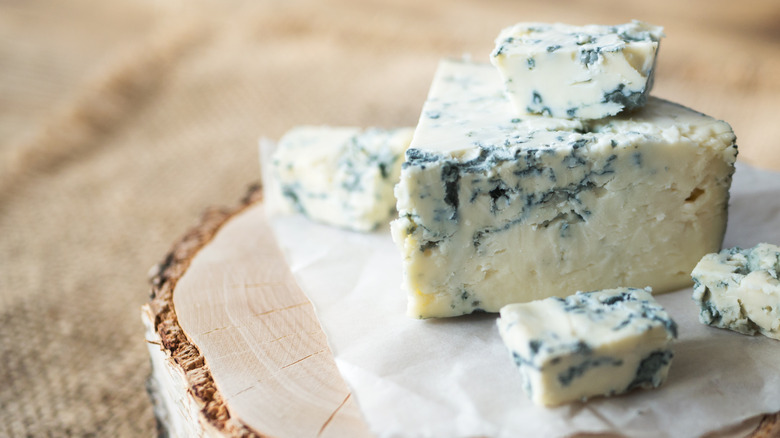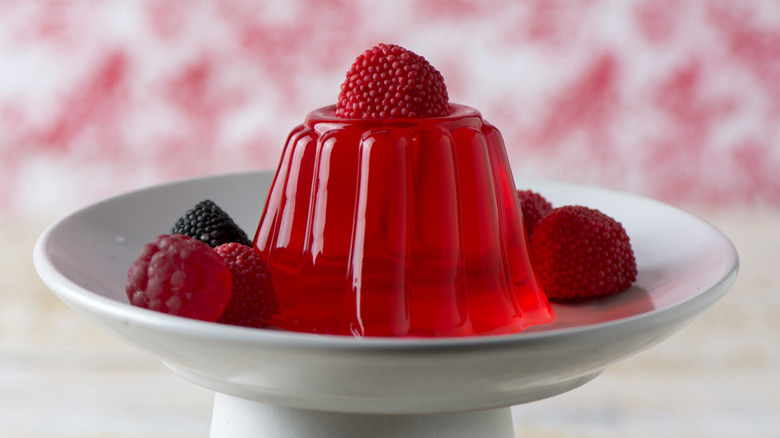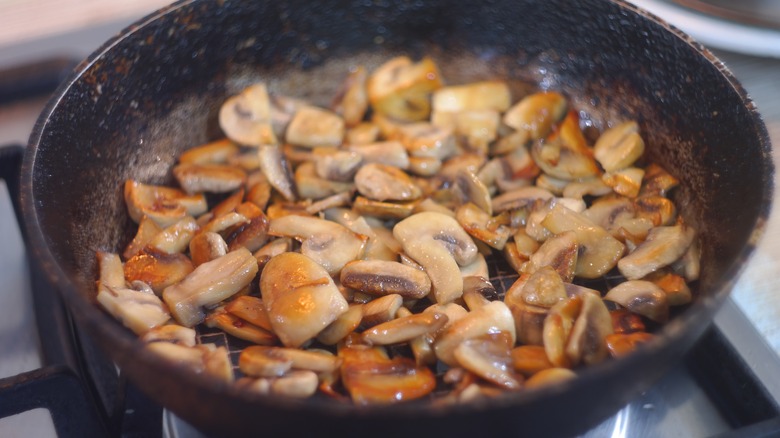13 Foods People Either Love Or Hate
Certain foods have always been polarizing. The chances are, you have a strong opinion about the ones on this list. And if you say you don't like them, you probably wouldn't be okay eating them.
So what makes these foods so divisive? Sometimes, it's a matter of texture and flavor. Certain foods can be an acquired taste, and when we grow up eating them, we are more likely to enjoy them. Other foods may be a matter of genetics. Gene variations lead to increased sensitivity towards certain flavors, particularly bitterness. Whatever the reason, you have your preferences. While these can change over time, it's hard to imagine ever enjoying a type of food you currently loathe.
So what foods are we talking about? Keep reading to learn about the foods people either love or hate. And as you scroll through each, decide which side you're on; the lovers or the haters.
Pineapple on pizza
Does pineapple belong on pizza? This hotly debated topic is reignited every time someone suggests ordering a Hawaiian. People get fired up even before the oven does, and everyone in the room seems to have an opinion as if they're part of a serious political debate.
This heated discussion has been going on for over half a century. The Hawaiian pizza was invented in 1962, not by an Italian or a Hawaiian, but by a Greek Canadian named Sam Panopoulos. Around this time, tiki-themed bars were popping up across North America. Piña coladas were sweeping the nation, so it made sense to see if pineapple pizzas could work, too. Panopoulos took the risk in hopes of attracting more customers to his Ontario-based pizza parlor. Sure enough, the strategy worked, and the Hawaiian pizza was born.
Seeing how it still exists today, there are obviously fans out there. Some folks enjoy that touch of sweetness on their salty, cheesy pizzas. Others can't comprehend why you'd want soggy fruit on a savory pie. But don't just take anyone's word for it. Regardless of how it sounds in theory, this is one pizza topping you must try for yourself.
Brussels sprouts
Kids hate many vegetables, but they usually come around given time. As adults, we now enjoy veggies we used to detest, like broccoli and green beans. However, Brussels sprouts are the exception. If you hated them as a kid, you probably still do today. No amount of boiling, roasting, or frying can make you enjoy these bitter-tasting balls — and this might not be your fault.
About 50% of people are born with a genetic variant that makes them sensitive to phenylthiocarbamide, (per American Journal of Human Genetics). This sulfuric compound gives Brussels sprouts their bitterness. If you have this gene, it's hopeless. You can melt butter and season those green orbs to death, but they'll still taste repulsive. Those that love Brussels sprouts have a mutation of this gene. To them, the sprouts are bitter when raw, but develop a slight sweetness when cooked. And, luckily for them, Brussels sprouts are packed with nutrients.
So how do you feel about this cruciferous veggie? Could you sprinkle some salt on roasted sprouts and snack away? It seems the jury is evenly split on this one.
Vegemite
Australians love their Vegemite, but most Americans detest the stuff. When they try it, they aren't sure what to make of it, or even how to describe it. So what does Vegemite taste like?
Vegemite is a concentrated spread made of yeast, malt barley, salt, and B vitamins. It was derived from British Marmite but has a thicker consistency. Imagine a super dense peanut butter but with a salty, yeasty flavor. If you've tried nutritional yeast, you have a vague idea of what to expect. However, Vegemite's taste is on a whole other level — and appears far too strong for American palates.
Australians cherish this childhood snack and can't fathom Americans' distaste. They're convinced we're just eating their national condiment all wrong. So when Hugh Jackman went on The Tonight Show Starring Jimmy Fallon, he was convinced Jimmy would love Vegemite if done right. According to most Australians, this means spreading butter followed by an ultra-thin layer of Vegemite on basic white toast. At the time, Jimmy Fallon and fellow audience members agreed it was delicious. But were they just being polite? We'll never know for sure.
Beetroot
Dwight Schrute, the ambitious Dunder Mifflin employee, had a famous side hustle as a beet farmer. He took this endeavor far too seriously, and nobody insulted his beets. So when Micheal Scott grumbled, "Beets are the worst," Dwight wasn't going down without a fight, "People LOVE beets!" (via IMDb). Neither party backed down, and perhaps, neither of them was wrong.
You see, beets have something called geosmin. This organic compound is found in soil and gives off a strong aroma reminiscent of the earth after a fresh rain. While that sounds beautiful, humans are extremely sensitive to geosmin. They can pick up the smell at concentrations as low as 5 parts per trillion, notes the American Chemical Society, which just means it's very strong. When something is that powerful, people have a strong reaction.
Some find beets pleasantly sweet and enjoy their slight earthiness. Others are so sensitive to geosmin that beets taste like biting into fresh dirt. Unfortunately, this dirt-like flavor isn't from the soil. No amount of scrubbing and cooking can wash away the geosmin. So depending on your sensitivity, you may have been destined to love or hate beets from the start.
Mayonnaise
Mayonnaise is everywhere and is one of the most commonplace condiments. This fatty spread makes everything just a bit more satisfying. Many can't imagine a sandwich without mayo, and it's the base of many other sauces. Thousand island dressing and aioli both use a mayonnaise base. But mixing mayo with ketchup or sriracha is enough to make us crave more fries. It's no surprise that in 2021, mayonnaise was the most widely sold condiment in the United States, raking in $164 million (via Statista).
But according to an interview in Popular Science, food sensory specialist Herbert Stone estimates that 20% of Americans dislike mayonnaise. Not only is this a substantial amount, but this population is very vocal. Chances are, you've heard a friend gag in response to your mayo usage. There's even a subreddit dedicated to mayo hate, where it's described as a "sickening egg whip for sickening people."
For many, mayonnaise triggers a sense of disgust. It might have to do with the texture; thick yet soft, creamy yet greasy — which is the exact same reason others love it. To each their own.
Marzipan
Marzipan is the Vegemite of the candy world. On Reddit, one fan raved, "Marzipan is great! If you can get it fresh, it tastes like little pillows of sweet almond," while another commenter confessed, "Marzipan is the only food that I will refuse to eat if offered it. Can't even get it down out of Midwestern politeness."
Loving almonds has no bearing on whether you'll like marzipan. Even if you enjoy almond paste, there's no guarantee you'll feel similarly about marzipan. Almond paste is made from almonds and sugar and occasionally uses egg whites as a binder. Marzipan also uses these three simple ingredients, but with noticeably more sugar — so much so, that many find it off-putting. It reminds them of cake icing, or worse, saccharin, which is 200 to 700 times sweeter than table sugar, notes the FDA.
Combining nuts with such intense sweetness also gives off an alcoholic flavor. The result can make the candy taste spoiled — which is highly unlikely. Because of the high sugar content, marzipan has a long shelf-life. As such, it's loved by confectionary artists who mold marzipan into figurines. Some people think eating these edible ornaments sounds fantastic, while others are horrified by the idea.
Sushi
Going out for sushi is a special treat. It's one of the most unique culinary experiences, and a very popular Japanese food internationally. Despite the high price tag, people are willing to hunt down sushi to satisfy that craving. Obviously, sushi is loved by many.
However, many people can't stomach the idea of raw fish. Maybe they had a bad experience, or detest the cold, slimy texture. But one theory is that people's hatred for sushi has evolutionary roots. We're inherently weary of anything that could carry pathogens. We're disgusted by the smell of rotten produce and the sight of mold. Even the Food and Drug Administration says eating raw fish is risky because it's more likely to carry harmful parasites or bacteria. If you love sushi, will any of this information sway you? It's highly doubtful. Die-hard sushi fans are willing to take the risk, and you could also always just get vegetable sushi if you're super worried.
Cilantro
Cilantro might be the most divisive food on the planet. For most of us, cilantro — or coriander, as it's known in some countries — tastes bright and grassy. It adds a fresh flavor to any dish, and we can't imagine Mexican food without it.
But if you dislike cilantro, chances are you won't go anywhere near the stuff. People that hate cilantro are adamant that it tastes like soap. In a CNN Larry King Live interview, Julia Child said that if she found cilantro in her meal, she would "throw it on the floor." There's even a Facebook group, I Hate Coriander, where people post poems and memes dedicated to their common enemy. If that wasn't enough, February 24th was officially declared International I Hate Coriander Day.
This hatred for cilantro is so intense that scientists were determined to get to the bottom of things. It turns out, genes influence your tastebuds. A Flavour Journal study found variations in specific olfactory receptor genes that pick up on cilantro's soapy odor and flavor. Certain ethnic groups might be more inclined to inherit this gene than others. Flavour Journal showed that the dislike for cilantro ranged from 3% to 21%. The highest percentages of distaste for cilantro were in the European and Caucasian groups. The study noted that African Americans, East Asians, South Asians, and Latinos are much less likely to have a distaste for cilantro. This helps explain why many people loathe cilantro, while some cuisines celebrate the herb.
Olives
Did you know plants have a unique defense mechanism to prevent animals from over-consuming them? Some plants carry chemicals that are toxic in large amounts. Others just taste plain horrific when consumed raw — and olives are one such item. It's safe to eat an olive directly from the tree, but it'll taste overwhelmingly bitter.
When olives reach your table, they've already been cured. This process removes most of the bitterness, making them deliciously salty and meaty. These savory snacks are an excellent addition to charcuterie boards, salads, or pizzas. And if you truly love olives, you can order an extra dirty martini.
But, for some people, the curing process isn't enough. Olives still taste too bitter and tangy, and the haters aren't quiet about their disgust. On Reddit, one user claimed, "Olives are evil grapes," and another said, "Olives are vile. They taste like soap mixed with perfume, sprinkled with pure, solidified evil." Those are strong words for a bite-sized fruit.
Pickles
Are you the type to pick pickles off your burger? Well, plenty of people at the table are happy to eat them for you. People either love or hate pickles — there's not much middle ground.
In a Reddit poll of 2,600 hundred participants, roughly ⅔s said they enjoy these fermented veggies. Perhaps it's the crisp, crunchy texture or the acidic salty flavor. Both these attributes have a solid place in culinary cravings. There's something super satisfying about loud, crunchy foods. In times of stress, that noisy crackle is music to your ears. Pickles are also full of acid and sodium — two things people crave. Desiring acidic foods can indicate low stomach acid, an underdiagnosed condition. Salt can also be addictive, and people crave it when stressed, dehydrated, or simply bored.
But the fermented vinegar vibes aren't loved by all. The remaining ⅓ of polled participants would remove all the pickles from their sandwiches. Heaven forbid they take a bite and ruin their appetite. But why do they hate them so much? Perhaps they're super-tasters with sensitivity towards bitter and sour flavors, and that pickle flavor infiltrates everything it touches. Plus, the bumpy wrinkly exterior isn't exactly appetizing.
Blue cheese
Some foods have an undeniably off-putting odor. Eggs, fish, and stinky cheeses smell horrible when you don't know what they are. Our faces wrinkle in disgust until someone yells, "Oh no, I'm just cooking fish!" Suddenly, your mouth waters with delight. This phenomenon is called backward smelling: Our brains associate a terrible smell with something delicious because of past experience.
Blue cheese's strong, pungent odor and flavor come from the bacteria penicillin roqueforti. At first, it might be off-putting, but blue cheese is delightful if you can overcome the initial smell. Unfortunately, not everyone has this ability. Taste and smell are so closely intertwined that overlooking an odor can feel impossible. Haters might also be sensitive to the butyric acid in blue cheese. This natural chemical is also present in rancid butter and vomit. When people taste butyric acid in blue cheese, it's no surprise they're sickened by it. So, is blue cheese an acquired taste? We're not sure. But even blue cheese connoisseurs know there's no point in trying to sway the naysayers.
Jell-O
There's always room for Jell-O! Or is there?
Many people would argue there's never room for jello. But the hatred of jello is really about texture. Jell-O is just a brand name for flavored gelatin. On its own, gelatin doesn't taste like much. It absorbs whatever flavors are cooked in. Texturally, it's jiggly and gel-like, and when you bite into jello, you're unsure if it's solid or liquid. That can be half the fun — or completely repulsive — depending on how you look at it. If you're not a fan of animal products, you might also be disgusted by the thought of eating animal collagen. However, with loads of sweeteners and artificial flavors, this is easy to overlook.
Jell-O has a long-standing place in American culture. In the '50s, it was an economical dish with a strong marketing campaign. Everyone ate Jell-O, and you might recall your grandma making a Jell-O bundt cake for the family potluck. In 2021, Jell-O has even been declared the official state snack of Utah, where people still love the stuff, (per Salt Lake Magazine). But outside of Utah, Jell-O isn't as popular as it used to be. So do people genuinely love this wobbly snack, or is it just cultural conditioning?
Mushrooms
Would you enjoy eating a rubbery fungus? Well, if you like mushrooms, you already do.
Mushrooms have a funky texture, and, yes, they're technically a fungus. But mushrooms also have a rich, umami taste. And when cooked slowly, the water evaporates, condensing that umami flavor even further. Mushrooms are easy to cook and pair well with so many other foods. If you're a fan of mushrooms, you can eat them in pasta, stir-fries, curries, omelets, and more. For mushroom lovers, it's one of those filler foods you keep on hand and tosses into everything.
But if you hate this food, you're not alone. As one Quora user puts it, "The earthy taste of mushrooms is repugnant, to say the least. [Would] you eat soil? No! The essence and vision of fungi is unacceptable to the palate." It seems a lot of the mushroom hate stems from perception. We guess it all depends on how you slice it.

